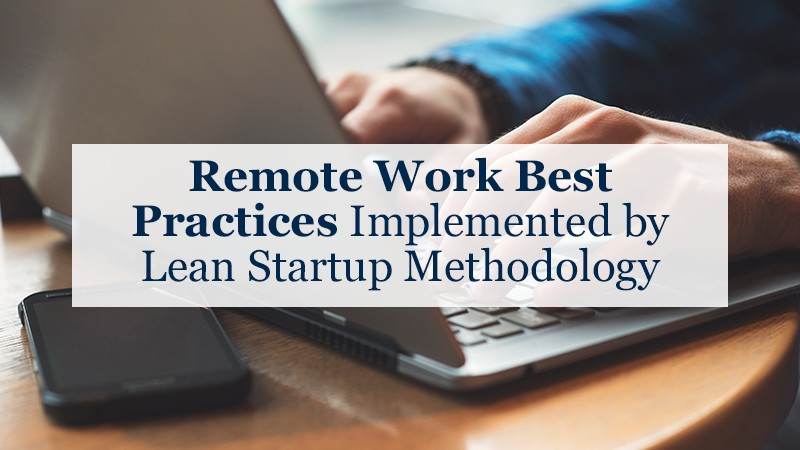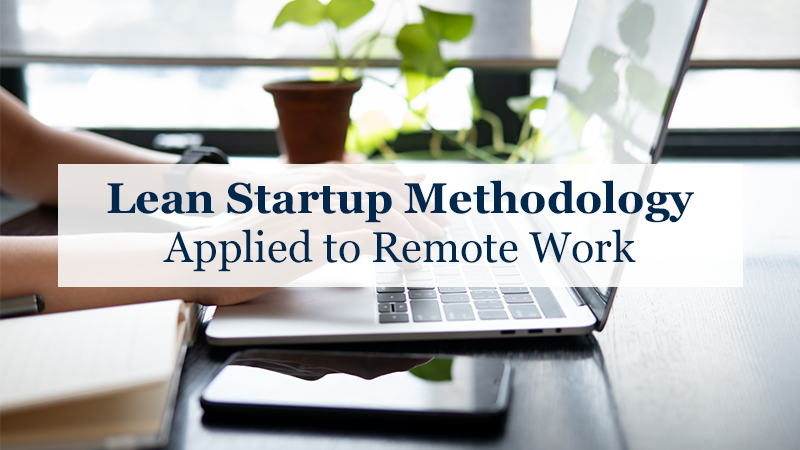Remote Work Best Practices Implemented by Lean Startup Methodology

Recently promoted to remote work? Finally got your corner office with a view. Only the view is of your yard and/or your neighbor’s car parked in front of your place. Sure. Promoted.

Recently promoted to remote work? Finally got your corner office with a view. Only the view is of your yard and/or your neighbor’s car parked in front of your place. Sure. Promoted.

With the recent pandemic forcing more companies to shift to an increasingly more remote work model, companies are discovering that they don’t know who their employees truly are yet or how their work should be done remotely. Make sure you’re online during business hours you’re told. Ok, so cover your um, bases, you think. Don’t let that green light in Skype or Microsoft Teams change to any other color but red. Red means you’re SUPER busy. Green means you’re busy – maybe, maybe not. Available? In theory, yes. But you could have trained the retired old lady next door to refresh that green light all afternoon while you snuck out for a round of golf.

It was to be the comeback of all comebacks. The most celebrated athlete in the world was making his grand return from a nearly two-year hiatus to the sport that he loved. He was returning to his old teammates and old city, both of whom desperately awaited his return. The world waited with bated breath as the Chicago Bulls made their way through the remainder of the 1994-1995 season poised to seriously contend for the NBA championship. The city of Chicago was practically bursting with excitement and had started making the plans for the celebratory parade to conclude that season as they cheered the return of the championship trophy to their city. Enter REALITY!
COVID-19 is hindering employee engagement in a multitude of ways. Not only are employees distracted, but they are also isolated. If you feel as though your employees aren’t engaged, you need to take action now. Engagement is an incredibly important part of developing company culture and productivity, and low employee satisfaction never yields good results.
When employees aren’t engaged, you don’t want to interact with human resources. You don’t want to reach out to upper management. You want to connect with direct management and supervisors; those who are listening to their team and who understand what makes their teamwork. If you can, reach out directly to employees. Find out what they need to feel valued.
Under COVID-19, employees frequently feel as though they aren’t as connected. Make sure that employees are getting enough face-to-face time in terms of video conferencing and phone conversations. If employees aren’t able to communicate with each other, they’re going to start feeling like their work doesn’t matter and isn’t valued. But it doesn’t take a lot to help them feel connected, just conscientious effort.
At this time, the last thing employees really want to have to worry about is their jobs. Tell employees about the direction that the business is taking and how the business is performing. Be honest and transparent. Let employees know what might be coming next. If people are going to have fewer hours, they need to know. The more honest you are with people, the more they will trust you.
There are a lot of things that employees may want to discuss during this time. They may need more time off. They may need to know about their health benefits. Or they may just need to know that they’re functioning well under these new constraints. Give employees a time when they can reach someone, such as their HR representative, and bring up their concerns.
When problems do arise that could potentially impact employees, don’t let it be a surprise. Everyone knows that there are new developments every day, and they will be understanding if these issues are brought up beforehand. Always have a plan. Don’t just give employees a problem, but also discuss what you’re going to do about it. This will make them feel more confident with the direction that the business is taking.
Everything else is uncertain. So employees need to be certain about something, and work is often that. Maintain structure rather than trying to do things on-the-fly. Set expectations clearly and make sure employees always know what they need to be doing. The more certain they are, the better.
It’s not easy to keep employees engaged, especially when they’re dealing with other issues such as quarantine and potential illness. But if you’re able to reach out to your employees and communicate with them more effectively, it will help. To start gauging your employee engagement and effectiveness, you need a plan. You also need data. To learn more, contact the experts at Starr & Associates.
According to the Harvard Business Review, 70% of employees are unable to select their own company’s strategy on a multiple choice quiz. As employee interests and company interests fail to combine, companies themselves become disconnected. Employee engagement is incredibly important to the health of a business. But how can it be improved?
Today, machine learning is becoming incredibly important for businesses hoping to remain competitive. From shipping and logistics to the medical industry, machine learning is being used to improve upon products and processes. Here’s what you need to know about integrating machine learning into your organization’s infrastructure.

By: Dmitriy
When most people think of ML, they imagine a team of data scientists, high overhead costs for computer hardware and timelines that stretch into quarters or a year before seeing results. But today the market is filled with automation tools and cloud-based computing power. ML, AI, and Big Data are available more than ever. It is now easier for medium to large-size businesses to start using and applying these advancements in business intelligence technology to grow and improve their business.

By: Sharon Mattei
John Tardy is a principal consultant at Starr & Associates and leads the Business Intelligence and Data Analytics practice area. He has a BS in Electrical Engineering and an MS in Biomedical Engineering from Rutgers University and an MBA in Management of Technology from Georgia Tech. He has worked with start-ups and served in senior leadership roles with some of the most recognized brands in the country. He pairs a depth of technical expertise with business savvy to deliver practical and impactful solutions for his clients.

One of the things I enjoy about our work in analytics is the variety of business problems we solve. While the specifics of the problem vary, our overall objective is always to derive value from the data. Putting the client’s needs first means that we adjust our approach to best fit the situation rather than fixate on a specific tool or pre-selected solution. This variety makes the work exciting, but it also creates challenges in staffing the appropriate skills. Over the years, I have come to refer to our solution to this challenge with the phrase “Analytics is a team sport.”